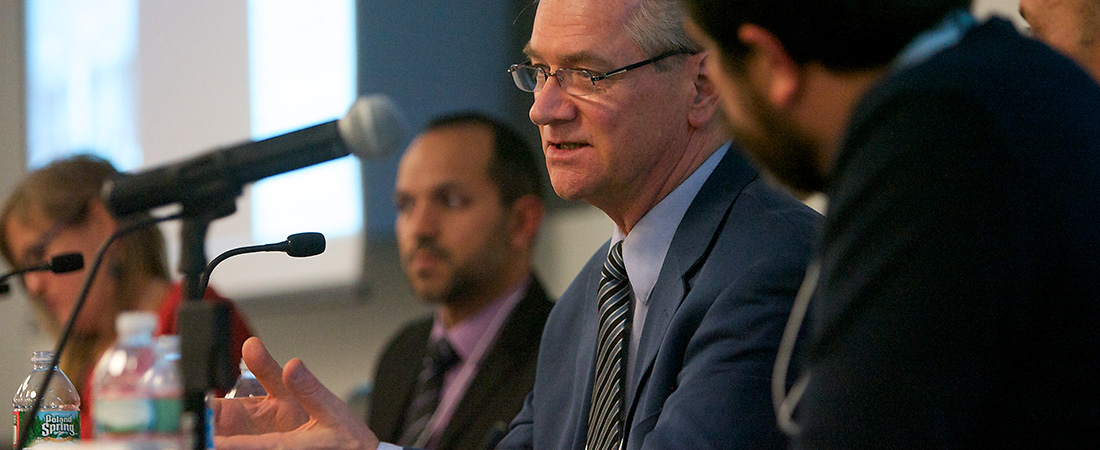Ending Youth Violence in Latin America

Ron Slaby addresses the audience during EDC’s forum on youth violence.
With decades of experience in the field, Ron Slaby is now seeing widespread progress in the collective mindset about youth violence in Latin America.
“Leaders are no longer questioning whether violence is preventable,” he says, recalling a recent meeting of public officials and public health experts in Cali, Colombia, sponsored by the World Bank. “Now they are saying, ‘Tell me what I can do to prevent it.’ ”
Slaby recently spoke about his experiences in Cali at the EDC forum “Solutions to Youth Violence in Latin America.” The forum brought together experts in public health, education, and international development, and focused on promising practices for youth violence prevention programs.
An antidote to violence is especially needed in Latin America and the Caribbean, which have 42 of the world’s 50 most violent cities, according to a report from the Citizen Council for Public Safety and Justice. The region also has the report’s number one city for violence: San Pedro Sula, Honduras, which has a homicide rate of 159 people per 100,000 residents.
Twenty-four-year-old Milthon Medina Giron of Honduras knows what it is like to grow up amid such violence. Now a teacher, Giron has seen firsthand the toll that violence can have—specifically on young people.
“When we talk about youth violence, it is important to mention that youth are affected by it, too,” says Giron.
Giron told the story of a student at his school who was upset that a teacher had caught him cheating on an exam. He threatened to kill her. “I know people who can kill her,” said the student, “or I can kill her,” Giron recalled the youth saying.
Even in the shadow of such threats, Giron is far from a pessimist. He was a participant in EDC’s Proyecto METAS, an education and workforce development program that is expected to reach over 40,000 at-risk youth across Honduras by 2014. When young people have constructive options, he says, they are less likely to be violent. And he pegged education as a key weapon in the fight against youth violence.
“We have time to make the change,” he said. “We have the time to make another world.”
Difficult numbers
The panelists agreed that change was possible—but it would require concerted effort among many partners and would have to address some sobering statistics about violence. This became clear when Enrique Betancourt, the former executive director of Mexico’s National Center for Crime Prevention and Citizen Participation, broke down the real story behind Mexico’s stated rate of 23 murders per 100,000 citizens.
“If you look at just being young and male in Mexico, you would find the rate of homicide is not 23, but 46 per 100,000,” he said. “And if you are young and male and you live in Chihuahua, then it’s 300 per 100,000.”
Betancourt stressed that understanding local contexts and local triggers are essential to curtailing youth violence, and that prevention efforts should not only be done at the state level. He believes the best way forward is to have local governments implement evidence-based strategies that fit their particular needs and contexts.
“Should we design a policy that addresses 23 murders per 100,000, or should we design a policy that addresses specific populations?” he asked.
Slaby offered a hopeful perspective on the issue, bolstered by 30 years of research showing that violence prevention can work. He remembers working on the first national plan to prevent violence during the early 1990s—a time when then-Surgeon General C. Everett Koop declared that violence in the United States had reached epidemic levels. Slaby looks to the many effective violence prevention interventions initiated during that period for lessons about how to address youth violence in Latin America.
The keys to change? According to Slaby, both evidence from research and wisdom from practice are needed, as are programs that enable youth to become actively involved in preventing violence.
And there is evidence that countries with high rates of violence can create programs that beat swords into plowshares.
Visiting Cali some years ago, Slaby observed a gun trade-in program that had become more popular than anyone had imagined. Initiated by the mayor and his wife, the program had started as an effort to get children to turn in toy guns in order to earn small privileges around town—such as admission to the movies or swimming pools. But before long, real guns were turning up in the collection, and the city’s mayor knew he was onto a violence prevention program that could work. He upped the privileges for turning in weapons and offered the promise of workforce training to any gangs that disarmed and signed a peace treaty.
It turned out that given a better option, many gang members were willing to leave their old life behind.
“They are young people,” said Slaby. “More than anything, they want opportunity; they want to be listened to; and they want the chance to be constructive.”
Joining Giron, Betancourt, and Slaby on the panel were two other experts with extensive experience working in Latin America: Laura Roper, a professor at the Heller School for Social Policy and Management, and Tim Cross, president of YouthBuild International. The forum was the first in a series of EDC events seeking to address strategies for preventing youth violence in developing countries.